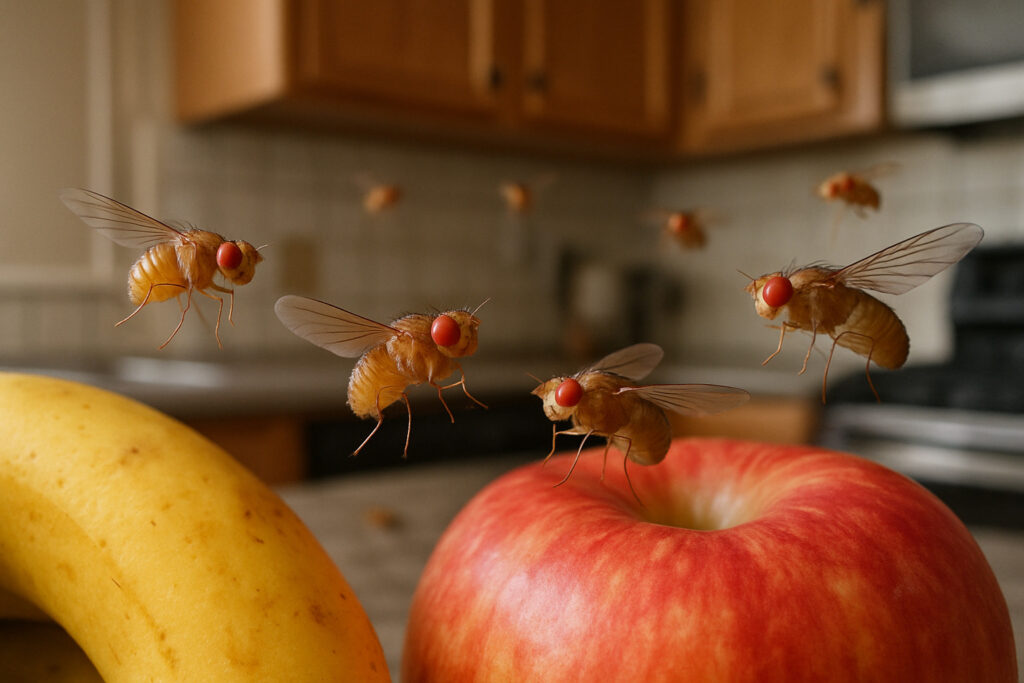Why Fruit Flies Turn Your Kitchen Into Their Personal Paradise
How to get rid of fruit flies is one of the most searched kitchen problems for good reason – these tiny pests can turn your culinary sanctuary into a buzzing nightmare almost overnight.
Quick Solutions to Get Rid of Fruit Flies:
- Remove all attractants – discard overripe fruit, clean spills, empty trash
- Set up ACV traps – mix apple cider vinegar + dish soap in a jar with holes
- Clean drains thoroughly – pour boiling water, use baking soda + vinegar flush
- Store produce properly – refrigerate ripe fruit, wash new purchases immediately
- Maintain prevention – clean surfaces daily, rinse containers before recycling
The science behind these infestations is startling. A single female fruit fly can lay up to 500 eggs at once, and those eggs hatch within just 24-30 hours. With their complete life cycle taking only 7 days, a few flies can explode into hundreds within a week.
These aren’t just annoying – they’re potentially dangerous. Fruit flies feed on yeast and bacteria in fermenting produce, then transfer those pathogens to clean surfaces through their feeding habits.
For food lovers who take pride in their kitchen spaces, fruit flies represent more than just a nuisance. They threaten the quality of your ingredients and the safety of your culinary creations.
The good news? With the right approach, you can eliminate them completely in 7-14 days and prevent future invasions.
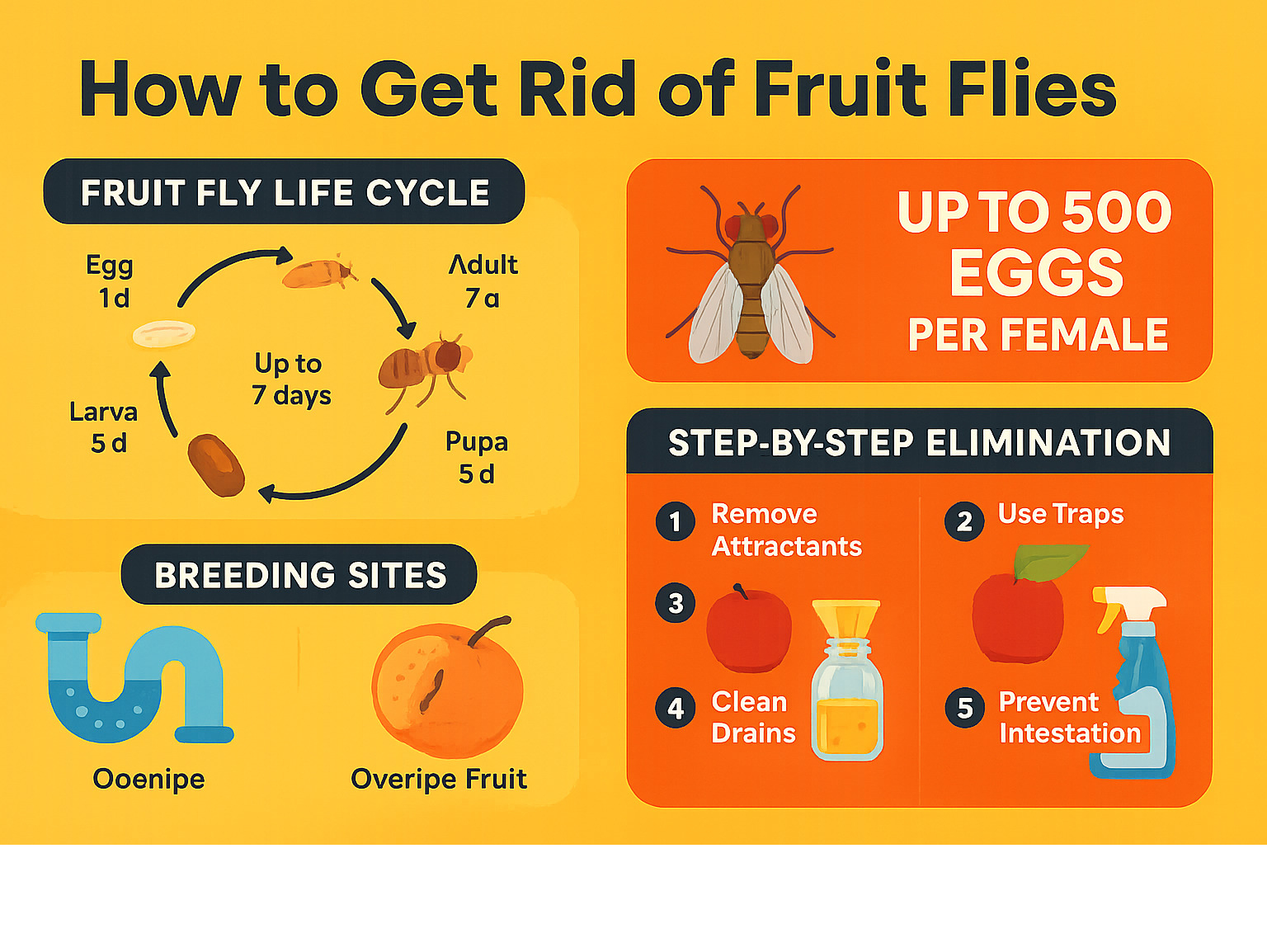
Key how to get rid of fruit flies vocabulary:
Fruit Fly 101: Why They Invade Your Kitchen
Understanding why fruit flies choose your kitchen as their breeding ground is the first step in mastering how to get rid of fruit flies effectively. These tiny invaders aren’t just randomly appearing – they’re following their biological programming that makes your kitchen irresistible.
The science behind their invasion is both fascinating and alarming. These miniature pests, scientifically known as Drosophila melanogaster, possess an extraordinary sense of smell that can detect the yeast and fermentation from overripe produce from incredible distances.
What makes them such formidable opponents? A single female fruit fly can lay up to 500 eggs at one time, with some producing up to 2,000 eggs throughout their lifetime. Those eggs hatch within just 24-30 hours under favorable conditions, and the complete journey from egg to reproducing adult takes merely 7 days.
This rapid reproduction cycle explains why a few fruit flies spotted on Monday can turn into a full-blown infestation by the weekend. Adult flies live 40-50 days, continuously mating and laying eggs throughout their lifespan.
Fruit flies enter your home through surprisingly small openings or hitchhike on produce you bring home from the grocery store, with eggs already laid on the fruit’s surface.
The health risks extend far beyond mere annoyance. Scientific research on fruit-fly health risks reveals these pests can carry dangerous bacteria including salmonella, E. coli, and listeria. Their feeding method is particularly unsanitary – they regurgitate digestive fluids onto food surfaces before consuming them.
Spot the Difference Quickly
Not every tiny flying insect buzzing around your kitchen is a fruit fly, and knowing the difference is crucial for effective treatment. Drain flies have distinctive fuzzy, moth-like wings and emerge from sink drains. Fungus gnats resemble miniature mosquitoes and hover around overwatered houseplants.
| Feature | Fruit Flies | Drain Flies | Fungus Gnats |
|---|---|---|---|
| Size | 1/8 inch long | Smaller, 1/16 inch | Tiny, mosquito-like |
| Color | Tan to reddish-brown | Gray to black | Dark gray to black |
| Wings | Clear, smooth | Fuzzy, moth-like | Long, delicate |
| Eyes | Large, red compound eyes | Small, dark eyes | Small, dark eyes |
| Behavior | Hover around fruit | Emerge from drains | Fly around plants |
| Breeding sites | Fermenting produce | Drain sludge | Moist potting soil |
True fruit flies have clear, smooth wings and distinctive large red compound eyes. They’ll typically hover around your fruit bowl, wine glasses, or anywhere fermentation occurs.
How to Get Rid of Fruit Flies Step-by-Step
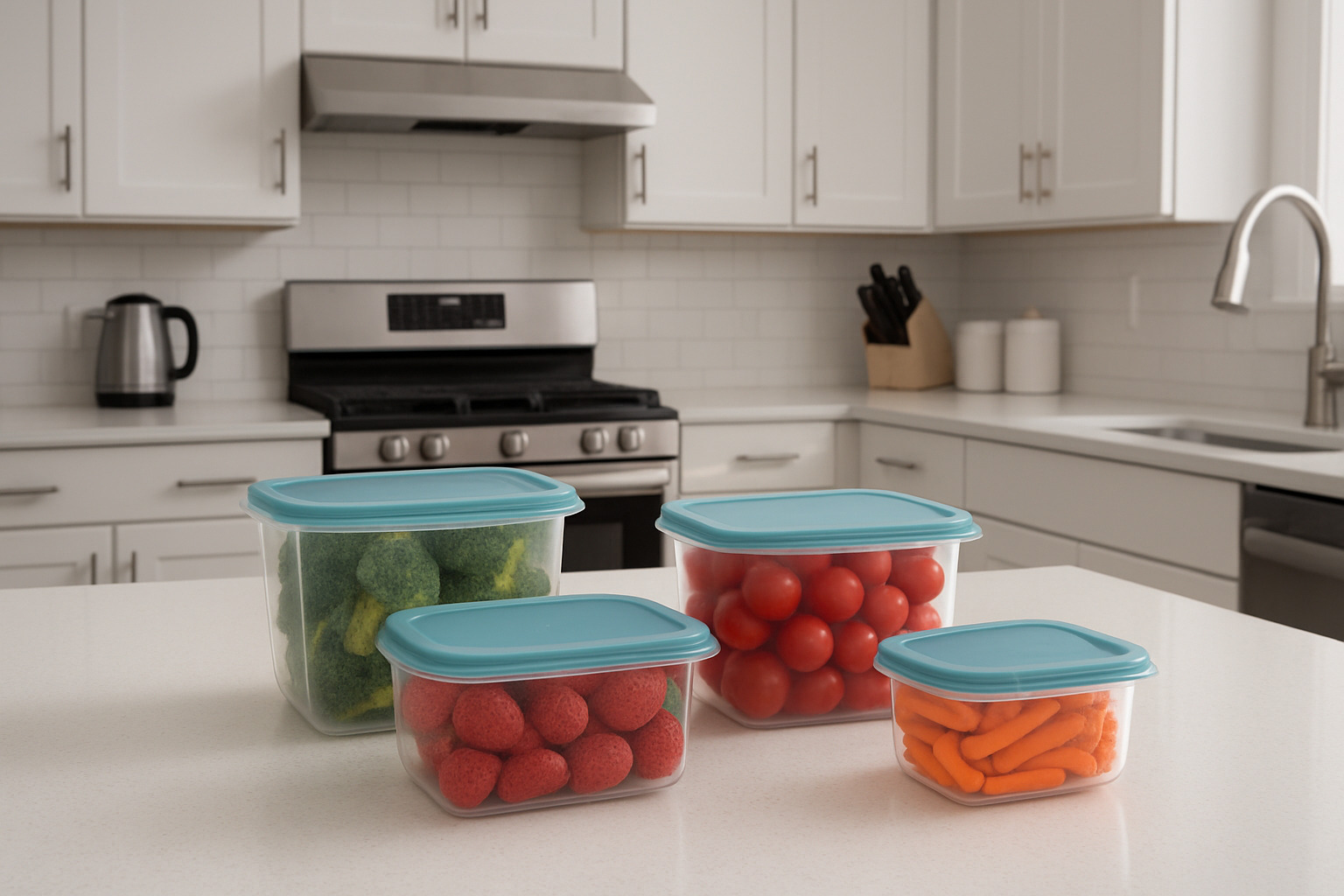
When you’re ready to tackle a fruit fly invasion, success depends on being methodical rather than frantic. The most effective approach to how to get rid of fruit flies combines eliminating their breeding grounds with strategic trapping.
Start by removing every single attractant from your kitchen. Walk through each area systematically, discarding all overripe or damaged produce immediately. Move any remaining fresh fruit straight into the refrigerator or sealed containers until your infestation clears.
Next, sanitize all surfaces with warm, soapy water, paying special attention to sticky spills and residues. Empty your garbage cans and recycling bins completely, then wash them out with hot water. Those empty wine bottles and juice containers in your recycling are five-star hotels for fruit flies.
Clean your drains thoroughly by pouring boiling water down each one, followed by scrubbing with a drain brush. For extra effectiveness, pour half a cup of baking soda down the drain, follow with half a cup of white vinegar, then cover the drain. After fifteen minutes, flush everything away with more boiling water.
Plug your sink overnight after cleaning – this simple step suffocates any remaining flies or larvae that might be lurking in your pipes.
How to Get Rid of Fruit Flies with DIY Traps
Once you’ve eliminated their breeding sites, homemade traps become your secret weapon. We’ve tested dozens of combinations, and the winners might surprise you.
The apple cider vinegar and dish soap trap reigns supreme for good reason. The sweet, fermented aroma of unfiltered apple cider vinegar is absolutely irresistible to fruit flies, while just a few drops of dish soap breaks the surface tension and causes them to drown. Pour half a cup of apple cider vinegar into a mason jar, add two to three drops of mild dish soap without stirring, then cover with plastic wrap secured by a rubber band. Poke six to eight small holes in the plastic wrap.
For paper funnel traps, roll a piece of paper into a cone shape and place it in a jar with some stale beer or wine at the bottom. The narrow opening makes it easy for flies to enter but nearly impossible to escape.
Strawberry scraps actually outperformed every other bait in our side-by-side testing, followed closely by slightly overripe banana peels.
How to Get Rid of Fruit Flies in Drains & Garbage
Drains are the hidden headquarters of many fruit fly operations. The boiling water method is your first line of defense. Pour a large pot of boiling water slowly down each drain, then follow up with a drain brush to scrub away any remaining organic matter.
Your garbage disposal needs special attention too. Run it frequently with cold water and grind some citrus peels to freshen and clean the blades naturally.
For compost bins and recycling containers, establish a routine of rinsing everything before disposal. More info about Sustainable Food Choices can help you manage food waste more effectively while keeping pests at bay.
DIY Fruit Fly Traps That Work (Recipes & Placement Tips)
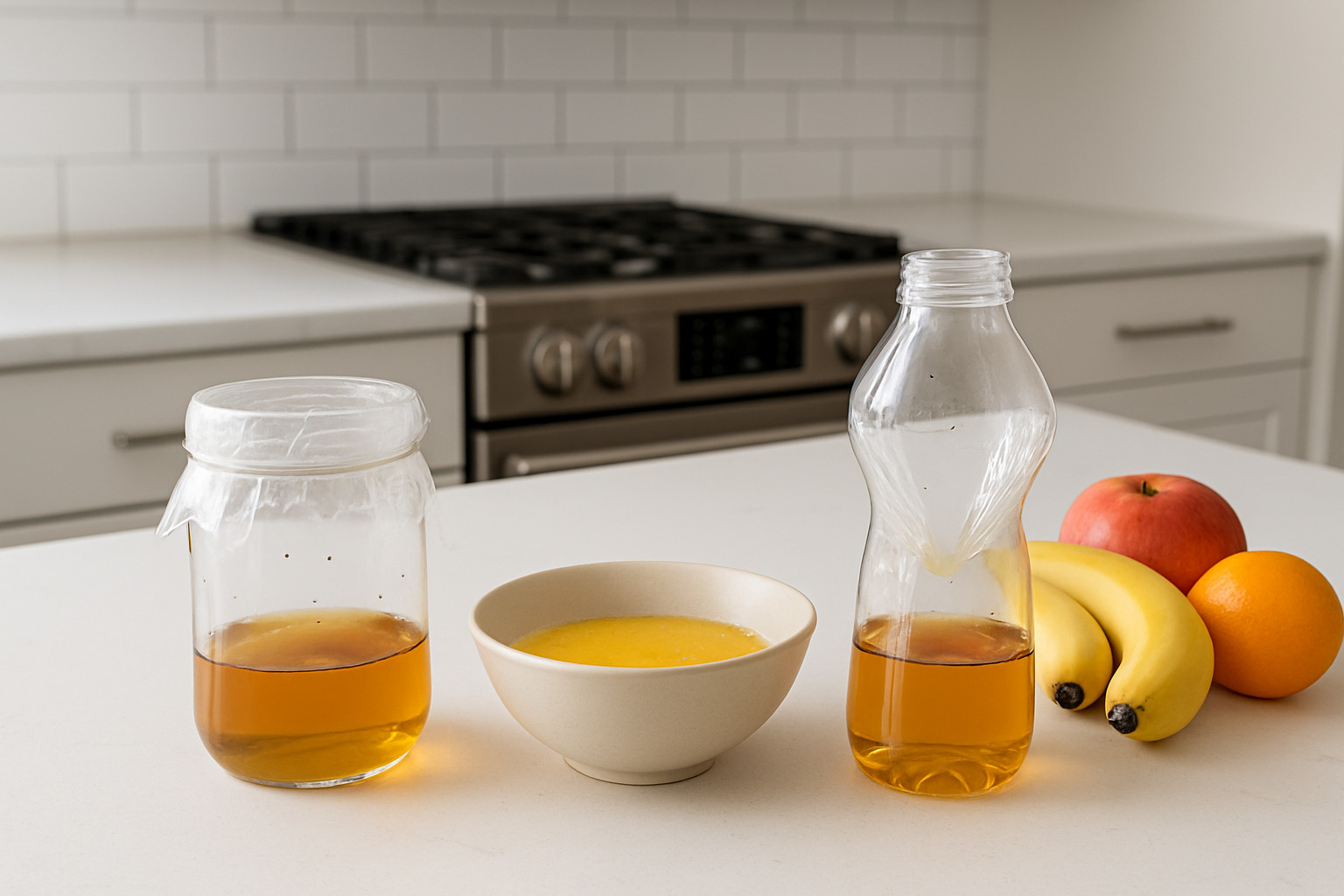
Creating your own fruit fly traps is surprisingly rewarding – there’s something satisfying about outsmarting these tiny invaders with items you already have in your kitchen. After extensive testing, we’ve found that homemade traps often work better than expensive store-bought versions.
The secret to successful trapping isn’t just the recipe – it’s all about strategic placement. Position your traps within two feet of where you see the most fruit fly activity. Multiple small traps beat one large trap every time. Fruit flies don’t travel far from their food sources, so spreading several traps around your kitchen creates a more effective net.
The key to maintaining effectiveness is refreshing your bait every 2-3 days. Old bait loses its appeal, and you’ll notice the catch rate dropping significantly after this point.
Build the Classic ACV-Soap Trap in 60 Seconds
This remains our champion trap because it’s foolproof and surprisingly neat. The combination works like a charm – apple cider vinegar provides the irresistible fermented aroma that how to get rid of fruit flies successfully, while dish soap breaks the surface tension to prevent escape.
You’ll need a mason jar with lid, a hammer and small nail, half a cup of apple cider vinegar, and just two drops of dish soap.
Use your hammer and nail to punch 8-10 tiny holes in the jar lid – they should be just large enough for flies to squeeze through but small enough to make escape nearly impossible. Pour the vinegar into your jar, add those crucial soap drops without stirring, then screw on the lid tightly.
This design prevents accidental spills and looks infinitely more presentable than plastic wrap versions.
Quick Bottle-Funnel Hack for Wine & Beer Lovers
If you enjoy a glass of wine with dinner or keep craft beer in the fridge, this trap turns your leftovers into fruit fly magnets. The narrow neck of wine and beer bottles creates a perfect natural funnel that makes entry easy but escape nearly impossible.
Simply add one to two inches of leftover wine, beer, or apple cider vinegar to your empty bottle. A single drop of dish soap seals the deal.
Here’s a pro tip: microwaving your vinegar mixture for 10-15 seconds intensifies the aroma dramatically. The heat releases more of those fermented compounds that drive fruit flies absolutely wild.
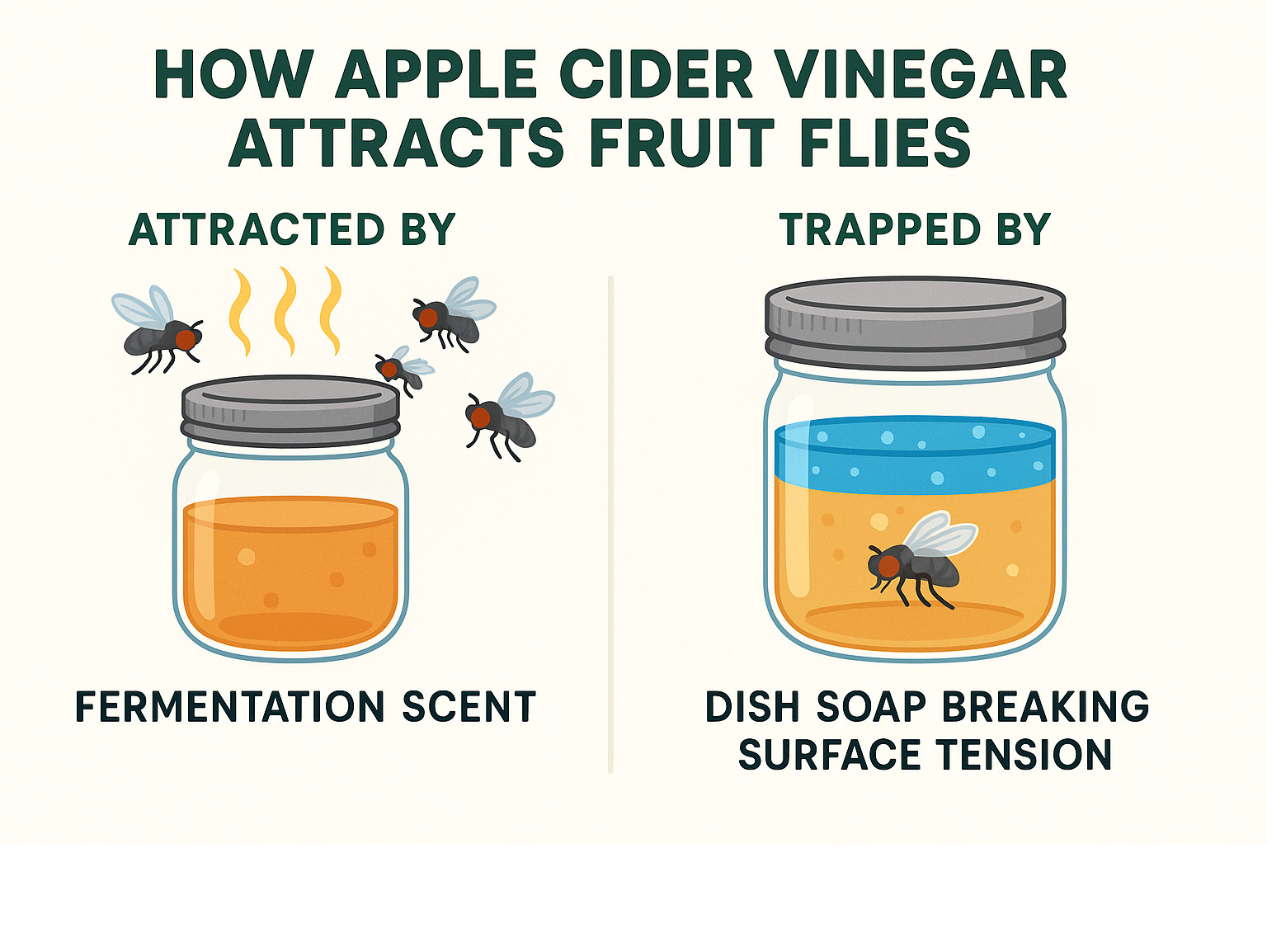
Our 24-hour testing revealed some surprising results about bait effectiveness. Fresh strawberry pieces emerged as the undisputed champion, catching 23 flies in a single day. Overripe banana peels came in second with 18 catches, followed by the reliable apple cider vinegar and soap combination at 15 flies.
For disposal, the most practical method is simply rinsing the trap contents down the drain and starting fresh.
Store-Bought Traps vs Homemade: Which Wins?
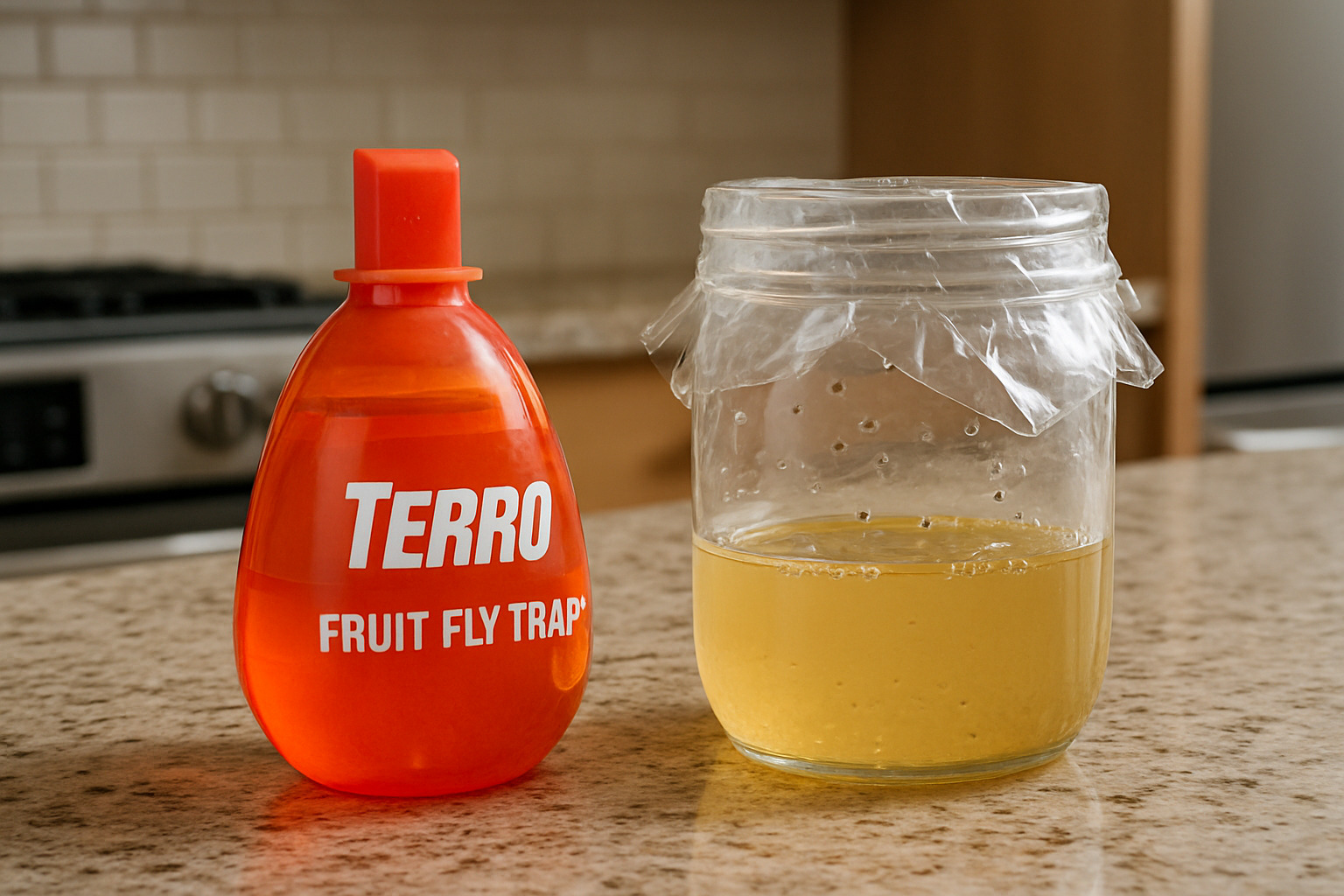
After countless kitchen battles with these tiny invaders, we decided to settle the debate once and for all. Do fancy commercial traps really work better than the humble mason jar sitting in your cupboard?
We put three popular commercial options head-to-head against our champion DIY trap. The Zevo Flying Insect Trap promises high-tech attraction with its LED light and fan system, retailing for around $10. The Terro Fruit Fly Traps come pre-baited and ready to stick anywhere for about $7. Aunt Fannie’s FlyPunch offers a no-fuss liquid solution at roughly $5.
Our week-long testing revealed fascinating results. The homemade apple cider vinegar and soap trap absolutely dominated, catching over 50 flies while costing just 50 cents to make. The Zevo plug-in managed a respectable 35 catches but at twenty times the cost. The sticky Terro traps nabbed 25 flies but looked terrible on kitchen counters.
Cost-effectiveness clearly favors the DIY approach, but there’s more to consider than just numbers. The Zevo trap wins hands-down for aesthetics – it looks like a sleek air freshener rather than pest control. Commercial traps offer the ultimate convenience – set them up and forget about them. DIY traps need fresh bait every few days and regular cleaning.
For serious infestations, we recommend starting with multiple DIY traps placed strategically around problem areas. Once you’ve knocked down the population, switch to a single commercial trap for ongoing monitoring.
The truth is, no trap works well if you haven’t addressed the root cause. Whether you choose homemade or store-bought, success depends on eliminating breeding sites first. More info about Locally Sourced Ingredients can help you select the freshest produce and avoid bringing these pests home in the first place.
Stop Fruit Flies Before They Start (Proactive Prevention)
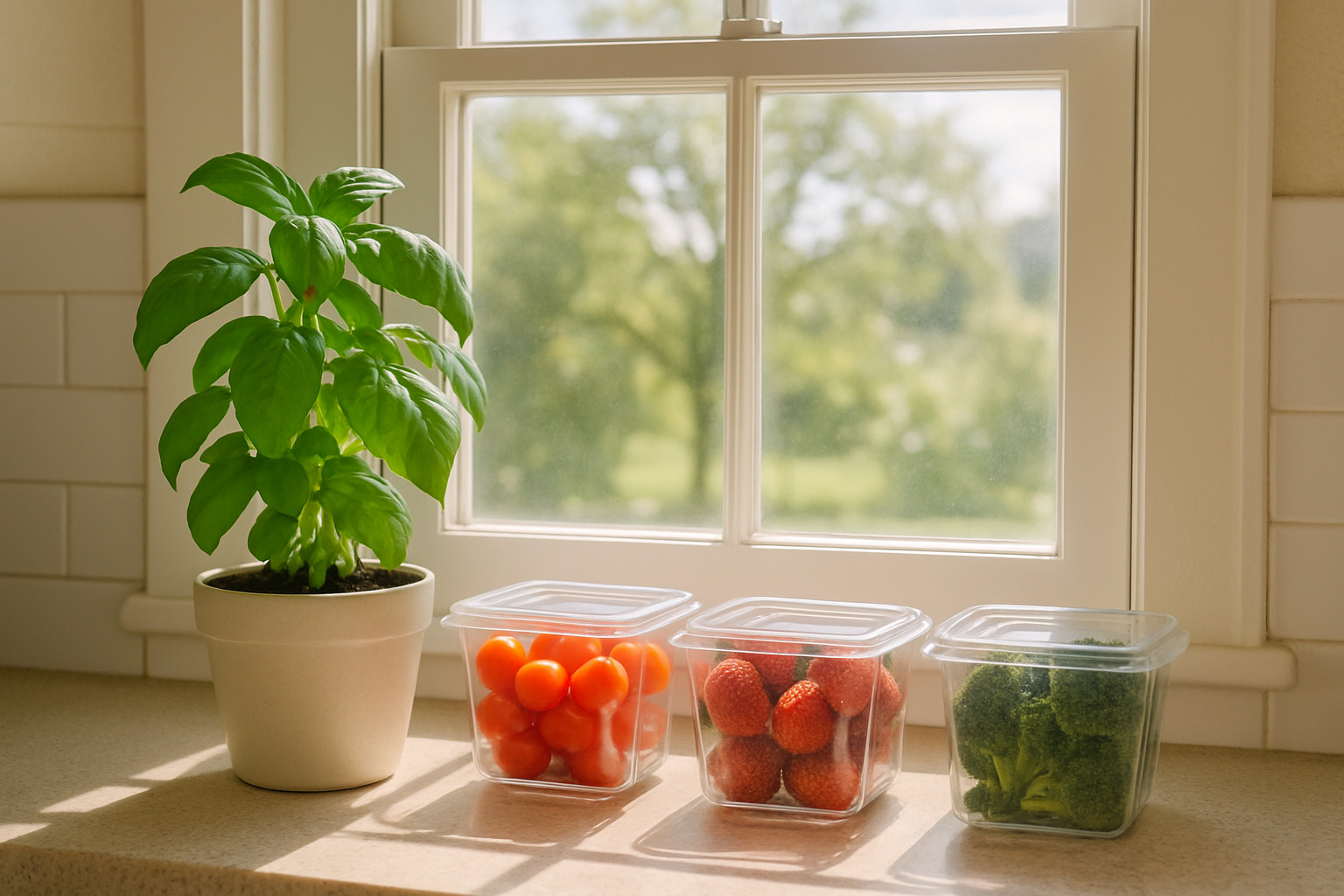
The best time to learn how to get rid of fruit flies is before they ever show up at your kitchen party uninvited. Prevention is so much easier than playing fruit fly detective later.
The moment you walk through your door with grocery bags, your prevention strategy begins. Wash all produce immediately under running water, giving fruits and vegetables a good scrub to remove any hitchhiking eggs. This simple step eliminates up to 99% of potential problems before they start. Scientific research on produce washing confirms that proper washing techniques are your first line of defense.
Instead of creating that Instagram-worthy fruit bowl on your counter, consider brown bag ripening for items that need time to mature. For produce that’s already ripe, strategic refrigeration is your friend – even items you normally store at room temperature can spend time in the fridge during peak fruit fly season.
Your daily kitchen routine should include a quick produce inspection. Spotting and removing overripe items before they become fruit fly magnets takes just a minute but saves hours of frustration later.
Weekly drain cleaning might sound tedious, but it’s surprisingly satisfying once you make it habit. Pour boiling water down all your drains every week, and treat them to a baking soda and vinegar flush monthly.
Don’t forget about those recyclables either. Rinsing bottles, cans, and containers before tossing them in the recycling bin eliminates sticky residues that call out to fruit flies like a dinner bell.
Temperature plays a bigger role than most people realize. Fruit flies thrive in warm, humid conditions, so keeping your kitchen cooler with air conditioning or fans creates an environment they find less appealing.
Nature provides some beautiful solutions too. Basil, lavender, and mint plants on your windowsills don’t just look lovely and smell amazing – their strong scents naturally repel fruit flies. You can also create an essential oil spray using 10 drops of peppermint or eucalyptus oil mixed with water for a natural deterrent.
For the ultimate barrier, 16-mesh window screens are worth the investment. Standard screens have holes large enough for fruit flies to waltz right through, but fine-mesh screens actually keep them outside where they belong. Combined with sealed storage containers for all your produce, you’re creating a fortress that even the most determined fruit flies can’t penetrate.
The key to successful prevention is making these practices as automatic as washing your hands before cooking.
Frequently Asked Questions about How to Get Rid of Fruit Flies
Why do infestations explode so fast?
If you’ve ever wondered how a single overripe banana can lead to dozens of flies seemingly overnight, you’re witnessing one of nature’s most efficient reproductive machines in action. How to get rid of fruit flies becomes urgent when you understand their incredible breeding speed.
The secret lies in their lightning-fast life cycle. Fruit fly eggs hatch within just 24-30 hours under ideal conditions, and the complete journey from egg to sexually mature adult takes only 7 days. This means that within two weeks, you can go from spotting a few flies to battling several hundred buzzing around your kitchen.
What makes this even more alarming is their reproductive strategy called “explosive breeding.” When conditions are perfect – think warm kitchen temperatures and that bowl of ripening peaches on your counter – female fruit flies can lay up to 100 eggs per day. It’s like they’ve evolved specifically to take advantage of our modern kitchens.
This evolutionary adaptation allows them to quickly capitalize on temporary food sources. In the wild, overripe fruit doesn’t last long, so fruit flies developed this rapid reproduction strategy to make the most of every opportunity.
Are fruit flies dangerous or just annoying?
While fruit flies won’t bite you like mosquitoes, dismissing them as merely annoying pests is a mistake that could compromise your family’s health. These tiny invaders pose legitimate health risks through bacterial contamination.
Here’s what makes them genuinely concerning: fruit flies have perhaps the most disgusting feeding method in the insect world. They regurgitate digestive enzymes onto food surfaces before eating, essentially vomiting on your food before consuming it. This process can transfer harmful bacteria like salmonella, E. coli, and listeria to clean surfaces.
Recent studies have shown that fruit flies can carry over 30 different types of bacteria on their tiny bodies. Even more troubling, they can transfer these pathogens to clean surfaces within hours of contact. Think about that the next time you see one land on your fresh fruit or cutting board.
For food safety, any produce or surfaces that have been in contact with fruit flies should be thoroughly cleaned before use. This isn’t just about being overly cautious – it’s about protecting your family from potential foodborne illness.
How long will it take to clear an infestation?
The good news is that with the right approach, most fruit fly problems can be resolved relatively quickly. With proper cleaning and trapping strategies, most infestations clear within 7-14 days. However, the timeline depends on several crucial factors.
Light infestations with fewer than 20 visible flies typically clear in just 5-7 days when you act quickly and follow our step-by-step elimination process. The key is being thorough from the start – half-hearted efforts often lead to recurring problems.
Thoroughness of cleaning makes the biggest difference in your timeline. Every missed breeding site can extend the elimination process significantly. That forgotten onion that rolled behind the refrigerator or the sticky spill under the toaster can sustain an entire population.
Trap effectiveness also plays a crucial role. Proper trap placement near activity areas and consistent bait refreshing can accelerate elimination dramatically. We’ve seen well-placed apple cider vinegar traps catch over 50 flies in just one week.
The most important factor is breaking the reproductive cycle. You need to eliminate breeding sites while simultaneously trapping adult flies to prevent new egg laying. Miss either component, and you’ll find yourself fighting the same battle weeks later.
Patience and consistency are your best allies. The flies you see today aren’t the ones causing tomorrow’s problem – it’s the eggs they’re laying right now that will become next week’s headache.
Conclusion
Successfully learning how to get rid of fruit flies comes down to understanding one simple truth: these tiny invaders are incredibly predictable once you know what they want. They’re drawn to fermenting fruit, they reproduce at lightning speed, and they absolutely hate clean, dry environments.
The science-backed approach we’ve shared – thorough cleaning followed by strategic trapping – works because it attacks the problem at its source. When you eliminate their breeding grounds and simultaneously trap the adults, you break their reproductive cycle completely.
Your kitchen should be a place of culinary creativity, not a battleground against buzzing pests. Whether you’re preparing fresh ingredients from New York City’s vibrant food markets or experimenting with new recipes for your next dinner party, fruit flies have no place in your culinary story.
The most important lesson? Act fast when you spot the first few flies. What seems like a minor annoyance today can become a major infestation within a week. But with the right approach, even severe infestations clear up in 7-14 days.
Remember to maintain your prevention habits even after the flies are gone. Weekly drain cleanings, proper produce storage, and immediate cleanup of spills will keep your kitchen fruit fly-free year-round.
At The Dining Destination, we’re passionate about helping food enthusiasts create amazing culinary experiences without the frustration of kitchen pests. A clean, organized kitchen is the foundation of great cooking and memorable dining moments.
Ready to explore more kitchen wisdom? Check out Our full Resource Guide for expert tips on ingredient selection, food safety practices, and culinary techniques that will lift your cooking trips.

